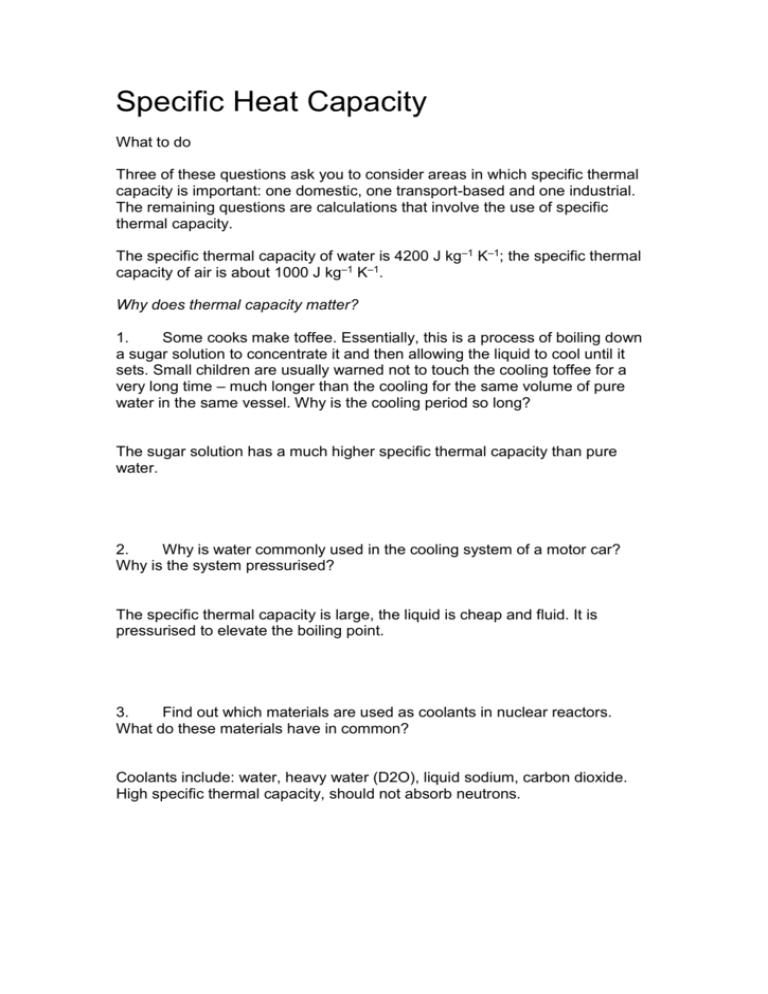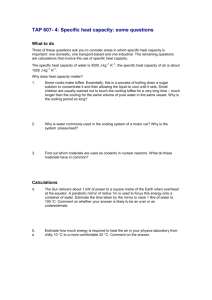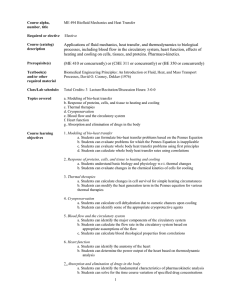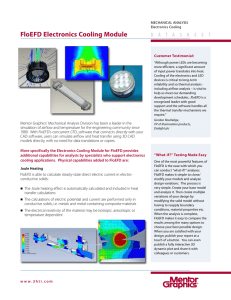Specific Heat Capacity
advertisement

Specific Heat Capacity What to do Three of these questions ask you to consider areas in which specific thermal capacity is important: one domestic, one transport-based and one industrial. The remaining questions are calculations that involve the use of specific thermal capacity. The specific thermal capacity of water is 4200 J kg–1 K–1; the specific thermal capacity of air is about 1000 J kg–1 K–1. Why does thermal capacity matter? 1. Some cooks make toffee. Essentially, this is a process of boiling down a sugar solution to concentrate it and then allowing the liquid to cool until it sets. Small children are usually warned not to touch the cooling toffee for a very long time – much longer than the cooling for the same volume of pure water in the same vessel. Why is the cooling period so long? The sugar solution has a much higher specific thermal capacity than pure water. 2. Why is water commonly used in the cooling system of a motor car? Why is the system pressurised? The specific thermal capacity is large, the liquid is cheap and fluid. It is pressurised to elevate the boiling point. 3. Find out which materials are used as coolants in nuclear reactors. What do these materials have in common? Coolants include: water, heavy water (D2O), liquid sodium, carbon dioxide. High specific thermal capacity, should not absorb neutrons. Calculations 4. The Sun delivers about 1 kW of power to a square metre of the Earth when overhead at the equator. A parabolic mirror of radius 1 m is used to focus this energy onto a container of water. Estimate the time taken by the mirror to raise 1 litre of water to 100 °C. Comment on whether your answer is likely to be an over- or an underestimate. Perhaps 100 s to reach 100 °C and 1000 s to boil away. Area of mirror is about 3 m2. So 3 kW delivered. One litre has a mass of 1 kg, assume an 80 degree temperature rise. Minimum time taken is (4200 J °C–1 ´ 80 °C) / 3000 J s–1 = 112 s but this does not allow for losses to the surroundings from the container which the Sun has to make up. This is an estimate of the energy needed to raise the temperature to 100 °C, it does not boil the water. Assuming no energy losses, it takes a further 800 s (minimum) to vaporise the liquid. An equally valid estimate – this time experimental – is to time your household kettle having read its electrical energy input from the base plate and then scale up or down its time to boiling accordingly. 5. Estimate how much energy is required to heat the air in your physics laboratory from a chilly 10 °C to a more comfortable 20 °C. Comment on the answer. About 1000 s on the basis of heating the air alone with no draughts. It would take much longer in reality. Assume the laboratory is 3 m ´ 10 m ´ 10 m, this leads to a volume of 300 m2. Assume further that the heating is just a question of warming up the air. The density of air is approximately 1 kg m–3 so energy = 300 kg ´ 1000 J kg–1 °C–1 ´ 10 °C, i.e. 3 MJ. A reasonable heater might deliver this in 1000 s (about 20 minutes). Most people would guess that the heating time would be much longer. This estimate ignores heating the contents of the room, other laboratories, etc. Our perception of temperature is affected both by the humidity of the air and by the cooling effect of any draughts. It would take much longer in reality.











